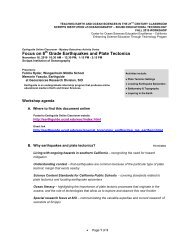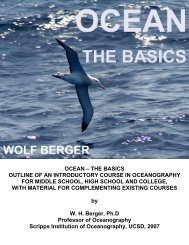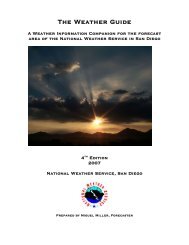Feed Me! The Story of Penny the Penguin Chick. - Earthguide
Feed Me! The Story of Penny the Penguin Chick. - Earthguide
Feed Me! The Story of Penny the Penguin Chick. - Earthguide
Create successful ePaper yourself
Turn your PDF publications into a flip-book with our unique Google optimized e-Paper software.
BRIANNA & OPA NATURE BOOK 1 GRADES K-3<br />
FEED ME!<br />
THE STORY OF PENNY THE PENGUIN CHICK<br />
Wolf Berger, Ph.D.<br />
with advice from Brianna<br />
1
FEED ME!<br />
THE STORY OF PENNY THE PENGUIN CHICK<br />
by Wolf Berger, Ph.D.<br />
with advice from Brianna<br />
Life in <strong>the</strong> Antarctic<br />
3
Copyright © 2006 by Wolf Berger<br />
ISBN 10: S<strong>of</strong>tcover 1-4257-2496-5<br />
Hardcover 1-4257-3759-5<br />
ISBN 13: S<strong>of</strong>tcover 978-1-425724-96-2<br />
Hardcover 978-1-425737-59-7<br />
All rights reserved. No part <strong>of</strong> this book may be<br />
reproduced or transmitted in any form or by any means,<br />
electronic or mechanical, including photocopying,<br />
recording, or by any information storage and retrieval<br />
system without permissionin writing<br />
from <strong>the</strong> copyright owner.<br />
This is a work <strong>of</strong> fiction. Names, characters, places<br />
and incidents ei<strong>the</strong>r are <strong>the</strong> product <strong>of</strong> <strong>the</strong> author’s<br />
imagination or are used fictitiously, and any resemblance<br />
to any actual person, living or dead, events, or locales<br />
is entirely coincidental. This book was printed<br />
in <strong>the</strong> United States <strong>of</strong> America.<br />
To order additional copies <strong>of</strong> this book, contact:<br />
Xlibris Corporation<br />
1-888-795-4274<br />
www.Xlibris.com<br />
Orders@Xlibris.com<br />
For background information on Life in <strong>the</strong> Antarctic see <strong>the</strong><br />
“<strong>Earthguide</strong>” outreach website at Scripps Institution <strong>of</strong> Oceanography,<br />
UCSD.<br />
4
<strong>Penny</strong> wants food<br />
This is <strong>Penny</strong>. She wants food.<br />
I am hungry. Please! <strong>Feed</strong> me!<br />
5
This is <strong>Penny</strong>’s mo<strong>the</strong>r. Her name is Jentoo.<br />
She is coming up from <strong>the</strong> sea to feed <strong>Penny</strong>.<br />
She walks over <strong>the</strong> rocks at <strong>the</strong> beach.<br />
She puts out her wings for balance.<br />
6
This is <strong>Penny</strong>’s bro<strong>the</strong>r <strong>Me</strong>etoo.<br />
He is hungry also.<br />
Who will get food next?<br />
7
Jentoo goes to <strong>Penny</strong>.<br />
She opens her beak.<br />
<strong>Penny</strong> puts her beak inside to get <strong>the</strong> food.<br />
8
Now <strong>Penny</strong> is tired. She has to rest.<br />
<strong>Me</strong>etoo is still hungry.<br />
Jentoo calls for<br />
<strong>Penny</strong>’s fa<strong>the</strong>r to<br />
bring food.<br />
9
He starts walking.<br />
<strong>Penny</strong>’s uncle Fredo<br />
follows him.<br />
Fredo has food<br />
for his own chicks.<br />
This is Jontoo. He is <strong>Penny</strong>’s<br />
fa<strong>the</strong>r. He has food.<br />
He hears <strong>the</strong> call.<br />
10
Sometimes <strong>Penny</strong>’s<br />
fa<strong>the</strong>r brings a small<br />
fish or a small squid.<br />
<strong>Penny</strong> likes fish.<br />
<strong>The</strong>y bring krill.<br />
<strong>The</strong>y caught <strong>the</strong><br />
krill in <strong>the</strong> sea.<br />
<strong>The</strong> krill are small.<br />
<strong>The</strong>y fit into <strong>the</strong><br />
beak <strong>of</strong> a penguin.<br />
11
<strong>Penny</strong>’s fa<strong>the</strong>r<br />
looks up.<br />
It is a long way<br />
up <strong>the</strong> hill.<br />
<strong>Penny</strong>’s fa<strong>the</strong>r and<br />
Fredo go up<br />
through <strong>the</strong> snow.<br />
<strong>The</strong>y bring <strong>the</strong> food<br />
to <strong>the</strong>ir chicks.<br />
12
<strong>Penny</strong> and her friends are waiting.<br />
<strong>The</strong>y are hungry. Which one is <strong>Penny</strong>?<br />
Which one is <strong>Me</strong>etoo? Who will get food?<br />
This time, <strong>Me</strong>etoo<br />
gets food from his<br />
fa<strong>the</strong>r.<br />
13
<strong>The</strong> parents have<br />
no more food.<br />
<strong>The</strong>y go back to <strong>the</strong><br />
sea to get more<br />
food.<br />
<strong>Penny</strong>’s parents jump in <strong>the</strong> ice-cold sea.<br />
<strong>The</strong> krill, <strong>the</strong> fish and <strong>the</strong> squid live in <strong>the</strong> sea.<br />
Her parents dive to catch <strong>the</strong>m for food.<br />
<strong>The</strong>y swim below <strong>the</strong> surface to look for krill.<br />
14
<strong>Penny</strong>’s neighbors<br />
When <strong>the</strong> chicks<br />
were little, only<br />
one parent could<br />
leave to get food.<br />
One parent had to stay because <strong>of</strong> <strong>the</strong> Big Brown Bird.<br />
He takes little penguin chicks to feed his own chicks.<br />
He is very dangerous.<br />
Watch out, <strong>Penny</strong>! Watch out, <strong>Me</strong>etoo!<br />
He has a big hooked beak. Just now<br />
he is taking a bath in <strong>the</strong> pool nearby.<br />
15
O<strong>the</strong>r big birds also<br />
are looking for food.<br />
<strong>The</strong>y look down from<br />
<strong>the</strong> sky.<br />
<strong>The</strong> little chicks stay<br />
close to <strong>the</strong>ir parent<br />
to be safe.<br />
16
Where is <strong>Penny</strong>’s cousin<br />
Eeny?<br />
Eeny hides from <strong>the</strong> big<br />
birds and also from <strong>the</strong><br />
Little White Bird.<br />
<strong>The</strong> Little White Bird<br />
steals food when <strong>the</strong><br />
chicks are eating.<br />
Watch out, Eeny!<br />
<strong>Penny</strong> can see<br />
her aunt Tardie.<br />
She is in her nest.<br />
She was late in<br />
laying her egg.<br />
Her chick is<br />
very small.<br />
17
Dallie and her sister<br />
Dellie are still hungry.<br />
But Ada has no more<br />
food. She runs away.<br />
<strong>The</strong> chicks run after<br />
her.<br />
<strong>Penny</strong> has a nice neighbor.<br />
Her name is Ada.<br />
Ada is a different<br />
kind <strong>of</strong> penguin.<br />
Can you see <strong>the</strong><br />
difference?<br />
Ada brings food to<br />
her chick Dallie.<br />
Ada’s cousin Bert is<br />
changing his fea<strong>the</strong>rs.<br />
He looks silly.<br />
18
<strong>Penny</strong> can see Petrella in her nest.<br />
Petrella is very big. She has huge wings.<br />
She also has a very big beak with a sharp<br />
hook. Petrella looks for food at sea and also<br />
on <strong>the</strong> beach.<br />
<strong>Penny</strong> is afraid <strong>of</strong> Petrella.<br />
19
<strong>Penny</strong> can see Shaggie<br />
<strong>the</strong> cormorant.<br />
She looks like a penguin.<br />
She swims and dives like a penguin.<br />
But she can fly!<br />
She flies up to her<br />
nest to feed her chick.<br />
He is big and very<br />
hungry.<br />
Please! More fish.<br />
20
<strong>Penny</strong> can see Vitta, <strong>the</strong> tern.<br />
Vitta has her<br />
nest nearby in<br />
<strong>the</strong> cliffs.<br />
Vitta is small but<br />
she has no fear.<br />
She has a sharp beak.<br />
She flies at <strong>the</strong> Big Brown Bird and drives it away.<br />
Thank you, Vitta!<br />
21
When <strong>Penny</strong> is big<br />
<strong>Penny</strong> and her friends are growing.<br />
Soon <strong>Penny</strong> will be big like her parents.<br />
She will get a shiny black and white coat.<br />
She will be ready to go into <strong>the</strong> water to catch krill.<br />
22
<strong>The</strong> krill is in <strong>the</strong> water.<br />
<strong>Penny</strong> will go into <strong>the</strong><br />
water to get food.<br />
<strong>The</strong> water will be cold.<br />
But <strong>Penny</strong> has lots<br />
<strong>of</strong> fat and fea<strong>the</strong>rs.<br />
She will be warm.<br />
She will be hungry.<br />
23
<strong>Penny</strong> will fly through <strong>the</strong> water.<br />
She will dive to get food.<br />
She will come up to get air.<br />
She will meet many o<strong>the</strong>r animals in <strong>the</strong> water.<br />
24
This is <strong>Penny</strong>’s cousin<br />
Chinnie. Chinnie jumps out<br />
<strong>of</strong> <strong>the</strong> water to go faster and<br />
to find his way.<br />
<strong>Penny</strong> will learn to jump just like Chinnie.<br />
<strong>Penny</strong> will meet Cesar and his kind.<br />
Cesar is big. He swims fast.<br />
<strong>Penny</strong> will not keep up with Cesar.<br />
25
Seals like to play catch.<br />
Some seals eat penguins. <strong>Penny</strong><br />
does not want to meet <strong>the</strong>m.<br />
<strong>Penny</strong> will meet<br />
many seals.<br />
This seal eats krill. It is resting on<br />
floating ice. Hi <strong>the</strong>re.<br />
26
<strong>Penny</strong> will see whales. Whales are huge<br />
animals, bigger than an elephant. <strong>The</strong>se<br />
whales eat krill. Hi <strong>the</strong>re.<br />
<strong>The</strong> big whale cannot see <strong>Penny</strong>.<br />
Can you see <strong>Penny</strong> swim under <strong>the</strong> big whale?<br />
27
Some whales eat seals. Also, <strong>the</strong>y eat<br />
penguins. <strong>Penny</strong> does not want to meet <strong>the</strong>m.<br />
How does <strong>Penny</strong> know which whales are<br />
dangerous? <strong>The</strong>y make shrill sounds and<br />
<strong>the</strong>y have big teeth. Careful, <strong>Penny</strong>!<br />
28
<strong>The</strong> most dangerous animal in <strong>the</strong> water is<br />
<strong>the</strong> leopard seal. Stay away, <strong>Penny</strong>!<br />
When <strong>the</strong>re is danger, <strong>Penny</strong> can jump out<br />
<strong>of</strong> <strong>the</strong> water. She will be safe on <strong>the</strong> ice.<br />
Can you see <strong>the</strong> penguins on <strong>the</strong> ice?<br />
29
<strong>Penny</strong> will find a mate. Her mate will help find<br />
or make a nest. <strong>Penny</strong> will lay two eggs. She<br />
will have chicks <strong>of</strong> her own. She and her mate<br />
will protect <strong>the</strong> chicks from <strong>the</strong> big birds in <strong>the</strong><br />
air and from <strong>the</strong> Little White Bird.<br />
<strong>The</strong> chicks will be very hungry.<br />
Please, more food!<br />
<strong>Penny</strong> will be busy.<br />
30
Notes for parents and teachers:<br />
<strong>The</strong> focus <strong>of</strong> <strong>the</strong> story is on <strong>the</strong> life <strong>of</strong> Gentoo <strong>Penguin</strong>s as seen on <strong>the</strong> shores <strong>of</strong><br />
Bransfield Strait, along <strong>the</strong> Peninsula <strong>of</strong> Antarctica. Two closely related penguin<br />
species are shown also: Adelie <strong>Penguin</strong>s (“Ada,” “Dellie,” “Dallie,” “Bert”) and<br />
Chinstrap <strong>Penguin</strong>s (“Chinnie,” jumping while traveling). <strong>The</strong> Emperor <strong>Penguin</strong><br />
(“Cesar”) was not seen; it does occur all around Antarctica but breeds on <strong>the</strong> ice,<br />
away from <strong>the</strong> water. It is <strong>the</strong> largest <strong>of</strong> <strong>the</strong> penguins (35kg vs. 5 kg for Gentoo).<br />
<strong>The</strong> scientific name for <strong>the</strong> Gentoo is Pygoscelis papua. <strong>The</strong> o<strong>the</strong>rs are P. adeliae,<br />
P. antarctica, and Aptenodytes forsteri. All four species are widely distributed in <strong>the</strong><br />
seas and islands around Antarctica. O<strong>the</strong>r penguin species (<strong>the</strong>re are 18 in all) live<br />
far<strong>the</strong>r north. All are restricted to <strong>the</strong> sou<strong>the</strong>rn hemisphere, to regions <strong>of</strong> high<br />
productivity. Some species only raise one chick per season (e.g., <strong>the</strong> Emperor),<br />
o<strong>the</strong>rs raise two if food is plentiful, o<strong>the</strong>rwise only one (even though <strong>the</strong>re are two<br />
eggs to begin with).<br />
Species o<strong>the</strong>r than penguins:<br />
Krill: Euphausia superba. <strong>The</strong>y are euphausid shrimp, about 2 inches long. <strong>The</strong>y<br />
feed on diatoms (“grass <strong>of</strong> <strong>the</strong> sea”) which are abundant around Antarctica in<br />
sou<strong>the</strong>rn summer. Krill is <strong>the</strong> staple food <strong>of</strong> Gentoo, Adelie and Chinstrap penguins,<br />
as seen in <strong>the</strong> spilled food on colony grounds.<br />
Fish, squid: generalized. No particular species.<br />
Big Brown Bird: Antarctic Skua, Catharacta antarctica. Predator.<br />
Big Bird, “Petrella”: Giant Petrel, Macronectes giganteus. Scavenger.<br />
Little White Bird, Snowy Sheathbill, Chionis alba. Scavenger.<br />
Cormorant, “Shaggie”: Antarctic Shag, Phalacrocorax bransfieldensis.<br />
Tern, “Vitta”: Antarctic Tern, Sterna vittata.<br />
Seals: sub-adult or female Fur Seals, Arctocephalus gazella; adult Crabeater Seal<br />
Lobodon carcinopha (note tooth marks on belly); Leopard Seal, Hydrurga leptonyx.<br />
Baleen whales: a pair <strong>of</strong> humpback whales, <strong>Me</strong>gaptera novaeangliae.<br />
Too<strong>the</strong>d whales: a group <strong>of</strong> orcas (one male, two females), Orcinus orca. An orca<br />
weighs as much as a large elephant (5 tons plus or minus 2 tons), and is much<br />
larger than any predator on land. From <strong>the</strong> point <strong>of</strong> view <strong>of</strong> a penguin, <strong>the</strong> presence<br />
<strong>of</strong> orcas is a mixed blessing: <strong>the</strong>y keep <strong>the</strong> penguin-eating leopard seals away, but<br />
<strong>the</strong>y also eat penguins if <strong>the</strong>y can catch <strong>the</strong>m (big ones preferred).<br />
Bransfield Strait is at <strong>the</strong><br />
nor<strong>the</strong>rnmost tip <strong>of</strong> Antarctica. It<br />
is reached by ship from<br />
Ushuaia, which is located in<br />
Beagle Channel in <strong>the</strong> sou<strong>the</strong>rn<br />
tip <strong>of</strong> Argentina.<br />
31
Technical notes<br />
Images are based on digital photos taken in January 2006, on a cruise to<br />
Bransfield Strait, Antarctica, using high-resolution Canon and Nikon cameras<br />
with 10x optical magnification. Two photos <strong>of</strong> “<strong>Me</strong>etoo” are by Karen Berger. Krill:<br />
SIO collections. Squid: based on a drawing by J.L. Sumich, modified. Fish larva:<br />
CalCOFI (SIO), simplified. Emperor <strong>Penguin</strong>, submerged whales: after Museum<br />
exhibits in Hamburg and in Bergen, redrawn. Leopard Seal: based on a drawing<br />
by D. Scott, greatly modified.<br />
Cruise participation (on M/V Corinthian II) was arranged by Dr. Nigella Hillgarth<br />
<strong>of</strong> <strong>the</strong> Birch Aquarium at Scripps. Cruise Leader: John Frick; Naturalist: Lyn Mair.<br />
Images were processed using Adobe Photoshop.<br />
Factual information on Antarctic fauna is based on:<br />
T. Soper and D. Scott, 2004, Antarctica – a guide to <strong>the</strong> wildlife. Bradt Travel<br />
Guides, UK.<br />
For a general introduction to marine biology, see:<br />
J.L. Sumich and J.F. Morrisey, 2004. Introduction to <strong>the</strong> biology <strong>of</strong> marine life. 8 th<br />
ed. Jones and Bartlett.<br />
<strong>Penguin</strong> expert Torrence Stockard (S.I.O.) checked identifications. Several<br />
colleagues and friends gave valuable advice. Thanks to all!<br />
Discussion Questions<br />
How do parents recognize <strong>the</strong>ir own chick? (By voice, mainly. <strong>Chick</strong>s from<br />
neighbors sometimes beg for food and are told to go away.)<br />
How do <strong>the</strong>y find back to <strong>the</strong> right place where <strong>the</strong> chicks are? (<strong>The</strong>y look when<br />
jumping, upon approaching <strong>the</strong> shore.)<br />
Why do some penguins spread <strong>the</strong>ir wings even when not walking? (Probably to<br />
cool <strong>of</strong>f. It gets warm under that black suit when <strong>the</strong> sun shines.)<br />
Why do penguins have webbed feet with strong claws? (For steering and<br />
pushing to jump, in <strong>the</strong> water, and for climbing <strong>the</strong> rocks and snow.)<br />
Will Aunt Tardie’s Eeny make it? (Unlikely. It must grow much bigger before fall<br />
comes with sea ice, and <strong>the</strong>re is not much time left.)<br />
Does Petrella eat penguin chicks? (Petrella eats dead animals on <strong>the</strong> beach and<br />
looks for food in <strong>the</strong> water.)<br />
Can you tell <strong>the</strong> difference between Gentoo and Adelie chicks? (Yes. Markings.)<br />
What is <strong>the</strong> best way to escape from a leopard seal? (Jumping out on <strong>the</strong> ice.)<br />
32
About this book, <strong>the</strong> author and his advisor:<br />
<strong>The</strong> book started out as a family weekend project, putting toge<strong>the</strong>r a story<br />
on Gentoo <strong>Penguin</strong> childhood using pictures taken during a week’s visit to<br />
<strong>the</strong> breeding grounds <strong>of</strong><br />
penguins around<br />
Bransfield Strait,<br />
Antarctica. During that<br />
visit, <strong>the</strong> wea<strong>the</strong>r was<br />
unusually favorable –<br />
no storms, no fog, no<br />
indication whatever that<br />
<strong>the</strong>se parts <strong>of</strong> <strong>the</strong> world<br />
<strong>of</strong>fer some <strong>of</strong> <strong>the</strong><br />
nastiest wea<strong>the</strong>r<br />
imaginable. Thus,<br />
conditions for taking<br />
photos were ideal.<br />
<strong>The</strong> story emerged readily enough, based on observation, but <strong>the</strong>re were<br />
requests for various additions and explanations, especially with regard to<br />
<strong>the</strong> leopard seal and o<strong>the</strong>r potentially threatening large animals. <strong>The</strong><br />
appropriate illustrations were created using Adobe Photoshop.<br />
W. H. Berger has degrees in geology and<br />
oceanography from Colorado University and <strong>the</strong><br />
University <strong>of</strong> California. He works at Scripps<br />
Institution <strong>of</strong> Oceanography, University <strong>of</strong><br />
California, San Diego. He has published more<br />
than 250 technical papers on ocean history,<br />
climate change, and marine ecology. His current<br />
research is on cycles in coral growth and on <strong>the</strong><br />
effects <strong>of</strong> Antarctic climate change in whale<br />
evolution. He is engaged in public education<br />
through an outreach website at SIO, and as a speaker for <strong>the</strong> Rotary Clubs<br />
in <strong>the</strong> San Diego area. This is his first children’s book.<br />
Brianna is in kindergarten (2006). She likes animals<br />
and stories about animals, and she likes <strong>the</strong> beach<br />
and <strong>the</strong> ocean. She pointed out what is <strong>of</strong> interest<br />
to children, commented on <strong>the</strong> choice <strong>of</strong> names for<br />
<strong>the</strong> various characters in <strong>the</strong> story, and edited <strong>the</strong><br />
text for clarity. She likes <strong>the</strong> story about <strong>Penny</strong> <strong>the</strong><br />
penguin chick and hopes <strong>Penny</strong> will never meet a<br />
leopard seal.<br />
Good luck, <strong>Penny</strong>!<br />
34



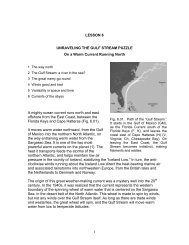

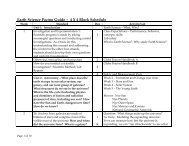
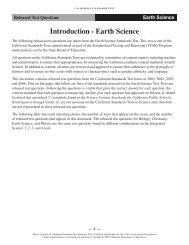
![Density Presentation 1 [.pdf] - Earthguide](https://img.yumpu.com/18214521/1/190x146/density-presentation-1-pdf-earthguide.jpg?quality=85)
